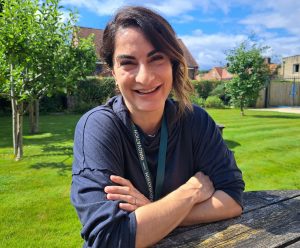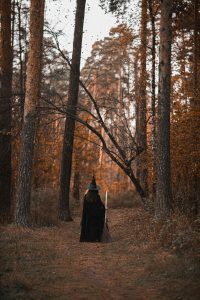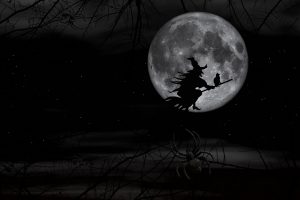Who were the witches of the South Downs?
October 8, 2024
 Anooshka Rawden, Cultural Heritage Lead, takes a deep dive into the history of witches in the South Downs.
Anooshka Rawden, Cultural Heritage Lead, takes a deep dive into the history of witches in the South Downs.
When we think of Halloween, alongside ghouls, ghosts and zombies, the figure of the witch comes to mind. All reflect ancient links to a time of heightened superstition, a need to remember the dead, and the turning of the seasons. The witch is tied to English history most notably in the 16th and 17th centuries, when social, political and religious instability saw a rise in accusations, punishment and executions.
In the late 16th and 17th centuries, the rise of the popular press and a unique set of circumstances increased unrest and uncertainty across English society. Unlike the East of England, counties such as Sussex and Hampshire were not particularly noted for high numbers of legal cases involving accusations of witchcraft in this period. However, records for the Assizes – a form of travelling court for the trial of serious offence – and the Bishop’s Courts, do preserve the names of those accused of witchcraft who came from rural communities in what is today the South Downs National Park. Some fared better than others.
 An Agnes Mowser from Fletching, accused in 1591 of bewitching Anne, the daughter of a Henry Clemens, was sentenced to imprisonment. Mother Mary Scutt of Bury was accused of witchcraft in 1603 for her work as a local herbalist. Jane Westwood, of Arundel, was accused in 1612 while working as a midwife and minister to the sick, but her case was thankfully dismissed.
An Agnes Mowser from Fletching, accused in 1591 of bewitching Anne, the daughter of a Henry Clemens, was sentenced to imprisonment. Mother Mary Scutt of Bury was accused of witchcraft in 1603 for her work as a local herbalist. Jane Westwood, of Arundel, was accused in 1612 while working as a midwife and minister to the sick, but her case was thankfully dismissed.
Around 75 to 85 per cent of those accused were women, but in some cases, men were accused and tried, such as in 1607 when Thomas Herold of Pulborough was accused of being “a witch” by his neighbour Elizabeth Hitchcock, who went on to level the accusation that he “did bewitch her husband’s cattle that they could not prosper for him”.
Most of those accused in Sussex appear to have been acquitted or given sentences of imprisonment, but some women and men accused of witchcraft were not so lucky. Some were sentenced to be hanged – such as Margaret Cooper in 1575, after being accused of bewitching a man and woman to death – or drowned. Pardons were few, but one example includes a Jane Mortymer from Hampshire, who in 1583 was accused of casting spells to bring about the death of an Elizabeth Randal.
As well as the names of real people accused of witchcraft, we also have many stories associated with witches, including that of an unnamed witch who lived on Ditchling Common and turned into a hare at night. This is a common theme in local folklore. There’s the story of a witch at Plumpton who had the power to stop carts passing her cottage, no matter how hard the horses would pull. Names like Nanny Smart, Butter Ede and Old Martha, paint a picture of older women, often living alone, accused of terrorising communities.
Why did so many accusations of witchcraft occur in this period of English history? It’s possible that they link to a simmering period of social uncertainty, fed by disease, plague, crop failure, religious change, the rise of the popular press, and eventually, civil war and the execution of a king, resulting in a situation where people’s fears and anger caused intense fractures within communities that could be easily capitalised on.
The law also reveals a growing fear of witchcraft. Although Pope Innocent VIII had declared witchcraft a heresy in 1484, in England it was the Witchcraft Act of 1541 issued by Henry VIII, which made witchcraft punishable by death and the seizure of property. It was repealed in 1547 by Henry’s son, Edward VI, but a new Act was introduced under Elizabeth I in 1562, which also transferred trials from the jurisdiction of the church to that of the state. She was eventually succeeded in 1603 by James I of England (and VI of Scotland) who had himself written a treatise on witchcraft in 1597 called the Daemonologie, after becoming convinced that stormy sea voyages in 1589 and 1590, which had delayed both his marriage to Anne of Denmark and his return to Scotland, was down to the malign influence of witches.
 Fear of witchcraft was evidently rife, with archaeological discoveries giving us witch bottles, often buried under or in front of the hearth in a home or under the floor of doorways. These stoneware jugs, known as Bellermines or Bartmann, or glass bottles, were filled with a variety of ingredients, which could include vinegar, bent pins or nails, hair, urine, wine, rosemary, shells, coins, earth, ash and then buried, acting as protection against the attention of witches and malevolent forces.
Fear of witchcraft was evidently rife, with archaeological discoveries giving us witch bottles, often buried under or in front of the hearth in a home or under the floor of doorways. These stoneware jugs, known as Bellermines or Bartmann, or glass bottles, were filled with a variety of ingredients, which could include vinegar, bent pins or nails, hair, urine, wine, rosemary, shells, coins, earth, ash and then buried, acting as protection against the attention of witches and malevolent forces.
As children dress up in pointy hats and paint their faces green to trick-or-treat, behind the costume are those independent women who knew the every-day magic of treating wounds, delivering babies, or simply surviving as women on their own – the likes of Agnes Mowser, Mary Scutt, Jane Westwood and others. We should perhaps spend a minute remembering that at this time in history, ordinary men and women – neighbours, friends and family across all communities – were fractured by ignorance and fear. It’s also worth recalling a memorial to the 72 men and women accused of witchcraft on the Orkney Islands, which bares the inscription “They wur cheust folk” (they were just folk).
